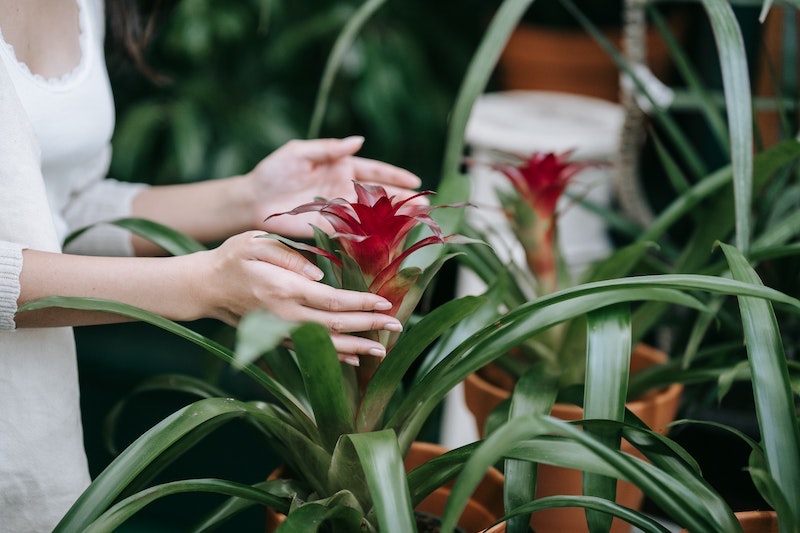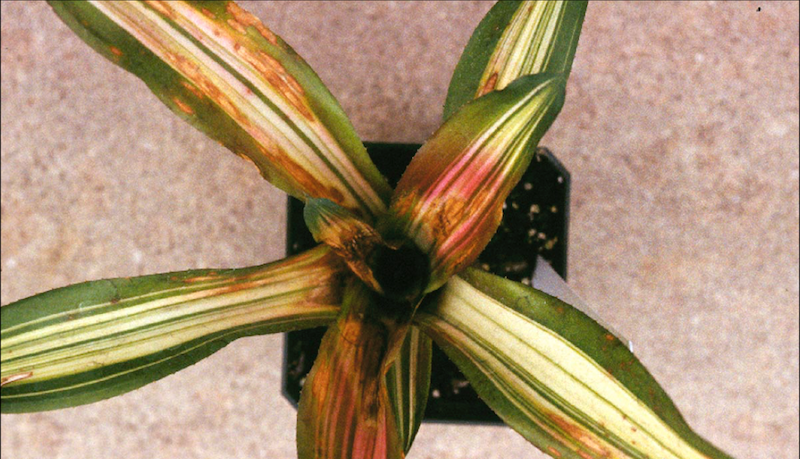Bromeliad Is Dying
Your bromeliad can usually recover from near death with a change in its environment. Bromeliads prefer bright indirect sunlight, warm temperatures, high humidity, and good drainage. For the optimal amount of light, choose a location that is near a west- or east-facing window. Direct bright light can scorch the foliage and leave brown spots. Typically, average home temperatures are fine for bromeliads, although air vents may dry and brown the foliage and should be avoided. Bathrooms and kitchens will naturally have higher humidity, making them ideal locations as long as bright light is present. Adequate light is necessary for blooms and bold colors. Yellow-brown plants might be getting too much light, whereas dark, elongated leaves can indicate a lack of light.

Overwatering and hard water are enemies of bromeliads. If the foliage is more yellow and soft, the plant is likely overwatered. You might be able to repot it in a fresh dry potting medium to save it. Hold off on watering the soil again for a few days to see if it recovers. If it is browning and doesn’t seem to be thriving, it could be reacting to minerals and salts in your water. Switch to filtered, distilled, or rain water.
Bromeliad Leaves Turning Yellow
Yellow or pale-looking foliage can mean your bromeliad needs fertilizer. The plant may look normal besides having a lighter color. Elongated leaves are generally a sign that your plant needs more light. If your plant is placed in an area with low light, it may grow dark, elongated leaves with little of their trademark colors. This problem can be reversed by moving the plant to a location with more sunlight. If you are not able to provide your bromeliad with enough natural light, you can supplement using LED or fluorescent bulbs for about 8-10 hours a day. If your bromeliad is losing its coloration and becomes elongated, the plant likely needs more supplemental light.
Many bromeliads have a cup formed by their central leaves. Keep fresh rainwater or distilled water in the cup. You should pour out the old water and fill it with clean water every few days. This will help to prevent bacterial growth and mineral buildup. Ideally the water you provide for your bromeliad should have a pH between 4.0-7.0. Smaller bromeliads are especially sensitive to salt and mineral buildup.
Bromeliad Pests
In outdoor bromeliads, mosquitos and aphids can be an issue. Mosquitos commonly use the cup of some bromeliads as a breeding area, so be sure to refresh the cup from time to time if your bromeliad is outdoors. Aphids target the roots of a bromeliad and can be tricky to catch. If you notice unusual stippling of the leaves, check around for aphids near the base of the plant and under leaves. You can control these pests by spraying them off with your garden hose or by using a mild insecticide like neem oil.
Scale is a pest that appears as small, raised brown ovals on leaves and can be hard to get rid of. Use a cotton swab dipped in rubbing alcohol to remove the adult scale, then rinse the bromeliad thoroughly under water to remove any eggs. Mealybugs are also a persistent bromeliad pest. Mealybugs are also oval but have a fuzzy appearance compared to scale. These pests can usually be wiped away with rubbing alcohol or sprayed off with a strong water stream.
Bromeliad Diseases
Bromeliads have a tendency to develop crown and root rot without proper watering. You can tell your bromeliad has crown rot if the center of the plant is stinky and mushy. Bromeliads are also susceptible to root rot due to their shallow root structures. Prevent rot by using a clean potting medium that doesn’t retain moisture for too long. The pot or container for your bromeliad should have adequate drainage as well.
Rust disease can appear in bromeliads as brown-red lumps on the underside of the foliage. Rust disease is typically caused by overwatering and a lack of good air circulation. Allow your bromeliad to dry out between waterings to prevent this fungal infection. Remove the infected leaves and throw them in the trash rather than composting them to prevent the spread of the disease. Another disease that can affect bromeliads is called leaf spot. This fungal infection occurs more frequently when bromeliads are exposed to overhead watering. Symptoms can differ depending on species, but typically varying sizes of sunken brown spots appear on the leaves.

Photography credit: Robert M? Leahy
Bromeliad Not Blooming
Choose an area with bright filtered sunlight for best performance. Adequate light is necessary for blooms and bold colors. You can also fertilize bromeliads to encourage blooming. Only apply fertilizer during the plant’s active growing season between spring and summer. Use an orchid fertilizer or organic formula for tropical blooming plants. Formulas with too much nitrogen can inhibit blooming.
This page contains affiliate links to products on Amazon. We may receive a commission for purchases made through these links.
 |
Author Chris Link - Published 6-24-2023 |
